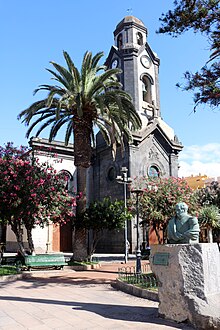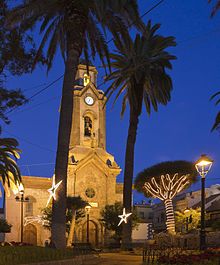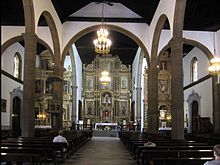Nuestra Señora de la Peña de Francia (Puerto de la Cruz)
The Church of Nuestra Señora de la Peña de Francia is the main church of the city of Puerto de la Cruz on Tenerife, built in the 17th century .
History of the church
In 1603, the regidor Antonio Franchi y Lutzardo divided the then largely undeveloped area of downtown Puerto de la Orotava, today's Puerto de la Cruz, into individual plots. He also planned a place for a church. In 1620 a chapel was built and the plot of land intended for the church was enlarged. Construction work on the church began in 1648. In 1697 the first building was completed. The right and left edges of the facade were made of ashlar . The corners ended in little turrets with pyramid roofs . The three ships had separate hip roofs . In 1729, open balconies were added to the west side of the two aisles. In 1822 the four entrance doors were built in and an organ was installed. The last major redesign was made between 1893 and 1898. The balconies and turrets were removed and a tower was built in front of the west side of the main nave, the three bodies of which become smaller towards the top. In addition, the entire facade was clad with stones. In 1958 the church was entrusted to the Augustinian order , who have been responsible for the building ever since.
The interior
The interior consists of three naves, which are separated by semicircular arches on Tuscan columns (in the style of basilicas ). The altar rooms are also separated from the nave by semicircular arches. The naves and the altar rooms each have a collar beam roof in the Mudejar style , reinforced by double girders that are decorated with stucco banding and rhombuses .
Equipment
Cross and pulpit
- In the left aisle there is a silver-covered wooden cross from the 17th century, which is carried in front of the processions of the “Brotherhood of Mercy” ( Hermandad de Misericordia ). The design and decorations of the cross indicate Cuban origins.
- The pulpit is located on the front column between the main nave and the left aisle. With its simpler design language, it differs from the other baroque furnishings of the church. It bears paintings by Manuel Antonio de la Cruz from 1809. The pictures on the parapet depict the four evangelists .
The altars
- The "Nuestra Señora del Carmen" chapel and its altar open from the left aisle, a work by the Frenchman Guillermo Veraud, which comes from the burned down monastery of Santa Catalina in Puerto de la Cruz. The altar has only one level with three niches. In the middle niche there is a figure of the "Virgin Mary" by the local artist Ángel Acosta Martín from 1954. This figure is carried on the annual processions of sailors. In the left side niche there is a saint Sebastian , who is assigned to the Canarian school of the 17th century, in the right a saint " Catalina ". The painting in the crown depicts the “Appearance of the Virgin Mary to Saint Felix of Valois ”. Above this picture is a harp, the Irish coat of arms, and below the inscription “Hibernia Semper”. The altar was commissioned by the Puerto-resident merchant Nicolás Bernardo Valois, he was of Irish descent. The wooden parts of the reredos are carved from rosewood and fine pine. There is also a statue of Saint Jude Thaddeus in this chapel.
- At the head of the left aisle is the altar of the "Great Power of God" ( Gran Poder de Dios ). The altar dates from 1708 and was redesigned in 1809 by Manuel Antonio de la Cruz (1750-1809). The reredos shows seven fields, three each in the lower and middle levels and one field in the upper level. The fields are laterally separated by twisted columns. There are figures in the niches in the lower fields. In the middle is the figure of Christ that gave the altar its name. It was made in Seville at the end of the 17th century . In the left niche is the figure of the “Virgin of Sorrows” ( Virgen de Dolores ), which was created by José Luján Pérez (1756–1815) for the Franciscan monastery in Puerto de la Cruz. The figure in the right niche represents Saint Peter as a penitent. It dates from the 18th century. The four pictures in the upper part of the reredos are by Luis de la Cruz . They show "Jesus and the Samaritan", the "Raising of Lazarus", "Jesus and Saint Peter walk on the water" in the uppermost part of the altar the "Transfiguration of Jesus".
- The altar Nuestra Señora (or Virgen ) de la Peña de Francia is at the head of the central nave. The retable dates from 1710 and was changed in 1835 and 1927. It is vertically divided into three parts by twisted columns decorated with grape leaves. The bases of the columns are decorated with angel heads. In the middle of the retable stands the namesake of the church, a figure from the 17th century, probably from Genoa . To the left of this is a figure of "Saint Francis of Assisi ", on the right the figure of "Saint Anthony of Padua ". The authors of these works from the 18th century are unknown.
- At the head of the right aisle is the "Altar of the Seamen" ( Mareantes ) or the " Heart of Jesus " ( Corazón de Jesús ). The altar was erected at the beginning of the 18th century by order of the Sailors' Association. In the middle niche on the lower level there is a figure of Christ from the 20th century. In the left niche is the figure of the “Virgin of the Rosary” ( Virgen del Rosario ). It is attributed to the Canarian school of the 17th century and comes from the property of the Dominican monastery in Puerto de la Cruz. The figure of "Saint Joseph with the Child" in the right niche was created in 1832 by José Perdigón Oramas. The upper level shows relief images of "Saint Telmo", the "Coronation of Mary" and "Saint Anthony of Padua". The relief image of a "Man of Sorrows" can be seen on the top level. These high relief representations are attributed to the sculptor Lázaro González de Ocampo (1651–1714) from Tenerife. All surfaces of the reredos are bordered by twisted columns. The altar is crowned by a medallion with an anchor.
- The chapel “Nuestra Señora de la Concepción” or “ San Patricio ” opens from the right aisle . The altar of this chapel is one of the oldest in the church. It dates from the 17th century. In the middle niche of the lower level is the figure “Nuestra Señora de la Concepción”, in the right niche there is a saint Patrizius. The paintings in the upper level and in the crown are paintings of the Canarian School of the 18th century. The altar is crowned by a medallion with a harp, the symbol of Ireland.
Others
- The lower choir (west choir) was closed in 1822 and provided with a lattice balustrade. It houses the choir stalls made of dark wood from the 18th century and a gallery.
- The organ with a classicist prospect is located on this gallery. It was built in Hamburg in 1818 by Joachim Wilhelm Geycke and Johann Heinrich Wohlien and has 12 registers , which are distributed over two manuals.
- Opposite the choir, at the foot of the main nave, there are two marble basins for the holy water, one of which is the old baptismal font.
- On the entrance side of the right aisle there is a baptistery , which is separated by a carved wooden lattice. There is a baptismal font made of Italian marble from 1733, which was used before the fire in the church of the Convent of Saint Catherine in Puerto de la Cruz. In the baptistery there are also the sculptures of "Christ on the Pillar" by an unknown artist in neoclassical style and of "Saint Dominic " by José Lujan Pérez (1756–1815)
- In the right aisle there is a baroque figure of Christ (Cristo de la Salud) from the 17th century.
Since May 12, 2003 the church and the works of art associated with it have been a listed building.
literature
- Manuel Hernández González: Tenerife, Patrimonio Histórico y Cultural . Editorial Rueda, Madrid 2002, ISBN 84-7207-134-0
- DECRETO 85/2003, de 12 de mayo Boletín Oficial de Canarias núm. 109, martes 10 de junio de 2003 Page 9495
Web links
Coordinates: 28 ° 25 ′ 1 ″ N , 16 ° 32 ′ 53.9 ″ W.












